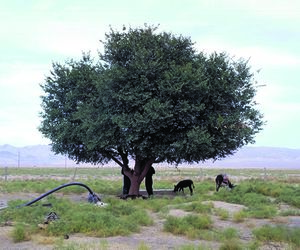Ulmus densa (Gintzburger et al., 2003)
| Ulmus densa (Gintzburger et al., 2003) |
Ulmus densa Litv.
Local name:
- Russian: вяз густой - vjaz gustoj
- Tadjik: Sada
- Uzbek: Sadda-kayragach, Kayragoch
Chromosome number: 2n = 28 (Grudzinskaya and Zahareva 1967).
Description and morphology: Large tree (height 5–15 m, taller in favourable locations) with dense pyramidal crown, sometimes in large bush (suckers). Dark bark, splitting. Young shoots slightly pubescent; buds (2–4 mm long). Leaves: asymmetrical, unequal at base, rigid, simple, alternate, oblong-ovate rounded, lower surface usually hairy; margin twice, occasionally three times dentate or serrate; lobes sharp tip-pointed. Petioles short, dispersal pubescent. Stipules deciduous, oblong-lanceolate with inconspicuous furrows on top. Perianth segments 4–8-metamerous with non-fused, imbricate lobes. Flowers: bisexual; in fascicles, on short pedicels, appearing before leaves, small, assembled in dense clusters on branches; 4–8 stamens opposite the perianth lobes. Ovary of 2 fused carpels.
Reproduction: Sexual. Anemophilous. Flowering and fruit maturation: March-April. Fruit: compressed samara, small nutlet with broad, oval wing (for wind dispersal), notched at tip. Seed: large embryo without endosperm. Seed coat thin. Seed dormancy induced by inhibitor in pericarp. Long stratification (5 °C) for 2–3 months stimulates germination.
Economic interest: Very resistant wood, slow growing. Used in buildings (carved pillars in mosques and houses), carpentry (traditional carving on main doors of old mosque, private houses, etc.) and coffins. Hollowed trunk and large branches traditionally used to make long lasting water pipes. Used in plantations along roadsides. Fuelwood.
Habitat: Present in mountains, valleys; sometimes isolated in the adyr near housing, farms and ‘mazar’ (graveyards). Widely naturalized and planted in deserts and semi-deserts near settlements.
Distribution: Middle and Central Asia (Pamir- Alai and Tien Shan).
